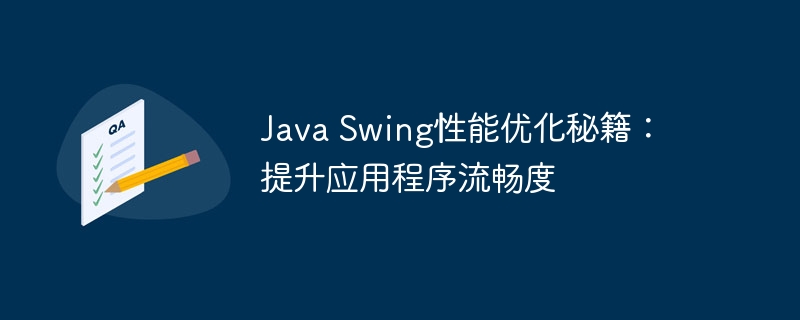

php editor Xiaoxin shares Java Swing performance optimization tips: improve application fluency. This article will teach you how to use optimization techniques and debugging tools to maximize the performance of Java Swing applications and make the user experience smoother. By studying this article, you will master some practical optimization methods to help your application run better and respond to user operations.
Double buffering is a common technique used to reduce flicker when drawing GUIs. By drawing the component's contents into an off-screen image before drawing it, it eliminates flickering and improves smoothness.
2. Avoid drawing unnecessary graphics
Every time a Swing component needs to be redrawn, it results in an expensive drawing process. Drawing unnecessary graphics, such as hidden or overlapping components, should be avoided. Use Swingapisuch asisOpaque()andisDoubleBuffered()to control the drawing behavior of the component.
3. Reduce layout operations
Layout operations are an expensive process in Swing. The number of layout operations should be minimized, such as updating by usingrevalidate()instead ofsetSize()andsetLocation()The size and position of the component.
4. Use custom drawing
For complex graphical effects or components that require a high degree of customization, using custom drawing may be an effective way to improve performance. By overriding thepaintComponent()method, you can more effectively control the drawing process of the component.
5. Optimize event processing
Event handling is a common performance bottleneck in Swing applications. You should avoid performing time-consuming operations in event handlers. Instead, use SwingUtilities.invokeLater() to dispatch such operations to the event dispatchthread.
6. Use lightweight components
Lightweight components (such asJPanelandJButton) draw faster than heavyweight components (such asJFrameandJDialog) quick. Use lightweight components whenever possible, especially when creating nested components.
7. Using SwingWorker
SwingWorker is a convenience class that can be used to perform time-consuming operations in a background thread. By delegating time-consuming operations to a SwingWorker, you can prevent these operations from blocking the event dispatch thread, thereby improving the responsiveness of your application.
8. Optimize memory usage
Memory leaks are a common performance problem in Swing applications. Objects that are no longer used should be properly released and static variables used with care to avoid memory leaks. Regular use of theSystem.GC()method can help the garbage collector free unused memory.
9. Using Performance Analyzer
Performance profilers, such as JProfiler or YourKit Java Profiler, can help identify performance bottlenecks in your application. By analyzing the call graph and thread activity, time-consuming areas can be identified andoptimizedaccordingly.
10. Optimization using Java Virtual Machine (JVM)
JVMOptimizations, such as enabling JIT compilation, using a different garbage collector, or adjusting the heap size, can have a significant impact on the performance of a Swing application. JVM options should be adjusted based on the specific needs of your application.
The above is the detailed content of Java Swing performance optimization tips: improve application fluency. For more information, please follow other related articles on the PHP Chinese website!




